Physical Address
304 North Cardinal St.
Dorchester Center, MA 02124
Physical Address
304 North Cardinal St.
Dorchester Center, MA 02124

Transform your bathroom with these 20 essential coastal bathroom design elements. From serene blue hues to natural textures, create a relaxing seaside retreat that combines authentic style with practical function.
Imagine stepping into your bathroom and instantly being transported to a tranquil seaside escape. The gentle hues of the ocean, the warmth of weathered wood, and textures reminiscent of sandy shores all combine to create a serene and rejuvenating space. As a historical renovation consultant, I’ve seen how a coastal bathroom design can transform an ordinary space into a daily retreat that honors both beauty and function.
Ready to capture the breezy, relaxed elegance of the coast in your own home? Let’s explore 20 essential elements that will help you create a bathroom that feels like a permanent vacation – no passport required.
The foundation of any coastal bathroom design begins with color. Blue and white are the quintessential coastal palette because they effortlessly mimic the ocean meeting sky, instantly creating that seaside connection. In my renovation work with historic properties, I’ve found these colors have a timeless quality that works in both contemporary and traditional spaces.
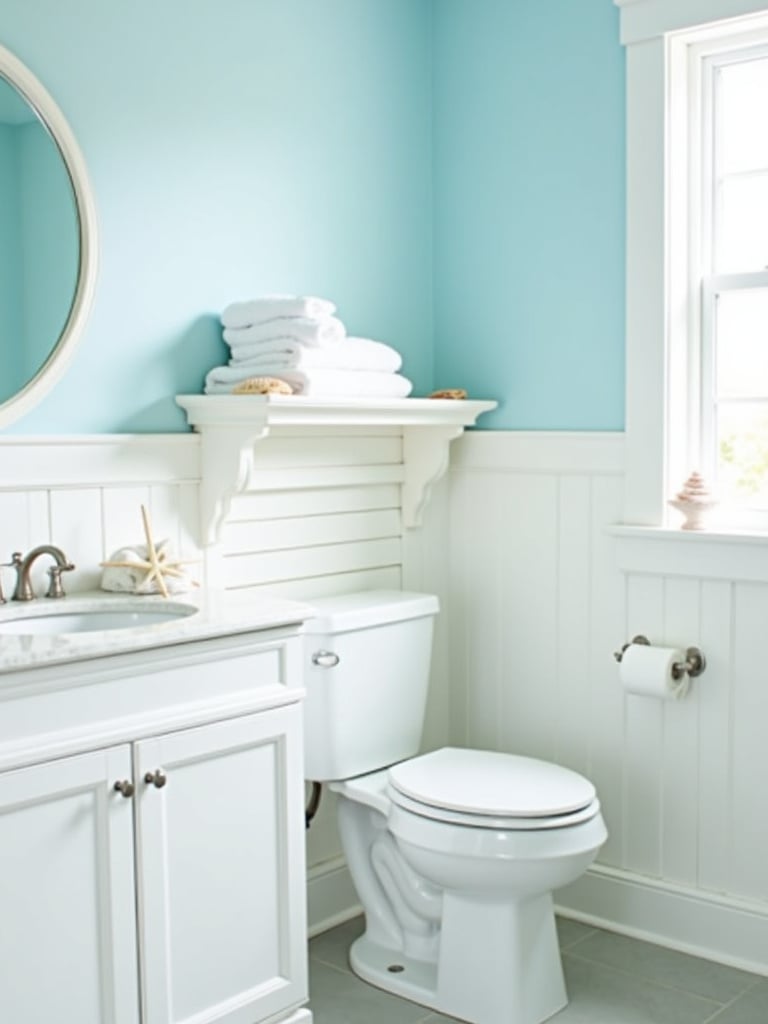
For blues, consider the full spectrum: light shades like sky blue or powder blue create an airy atmosphere, while medium tones like seafoam or teal offer more grounding presence. Deep navy can work beautifully as an accent, particularly in larger bathrooms. With whites, don’t limit yourself – bright white maximizes light reflection, while off-whites and creams add warmth and prevent the space from feeling clinical.
Here’s the catch… the bathroom’s lighting dramatically affects how these colors appear. Test paint samples on a large piece of cardboard and observe them throughout the day before making your final decision.
After establishing your color palette, it’s time to add dimension through texture. Natural wood and rattan are my go-to materials for bringing authentic coastal character into a bathroom renovation. These elements counterbalance the cool, smooth surfaces of tile and porcelain with organic warmth that instantly evokes seaside environments.
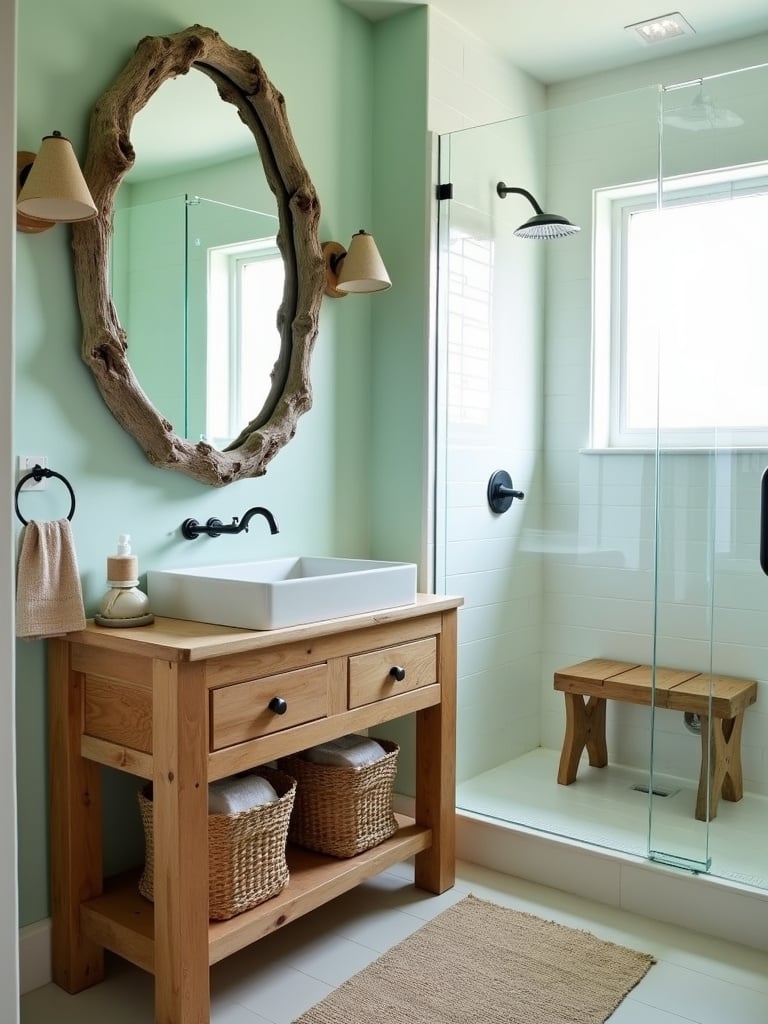
The beauty of wood in a coastal bathroom lies in its versatility. A reclaimed wood vanity tells a story through its weathered patina. A teak shower bench adds both function and spa-like luxury. Even simple wooden shelving or a driftwood-framed mirror can transform the space. For rattan, consider storage baskets, a pendant light, or even a small accent stool to introduce that woven texture that speaks of beach houses and summer breezes.
What really matters here is balancing these natural elements with your fixtures and finishes. The goal isn’t to overwhelm but to create points of visual and tactile interest that draw you into the space.
Nothing says “coastal” quite like shiplap walls. This architectural element has become synonymous with seaside style, and for good reason. The horizontal lines create visual interest while evoking the weathered exteriors of beach cottages. I’ve incorporated shiplap into countless bathroom renovations, and it never fails to transform the space.
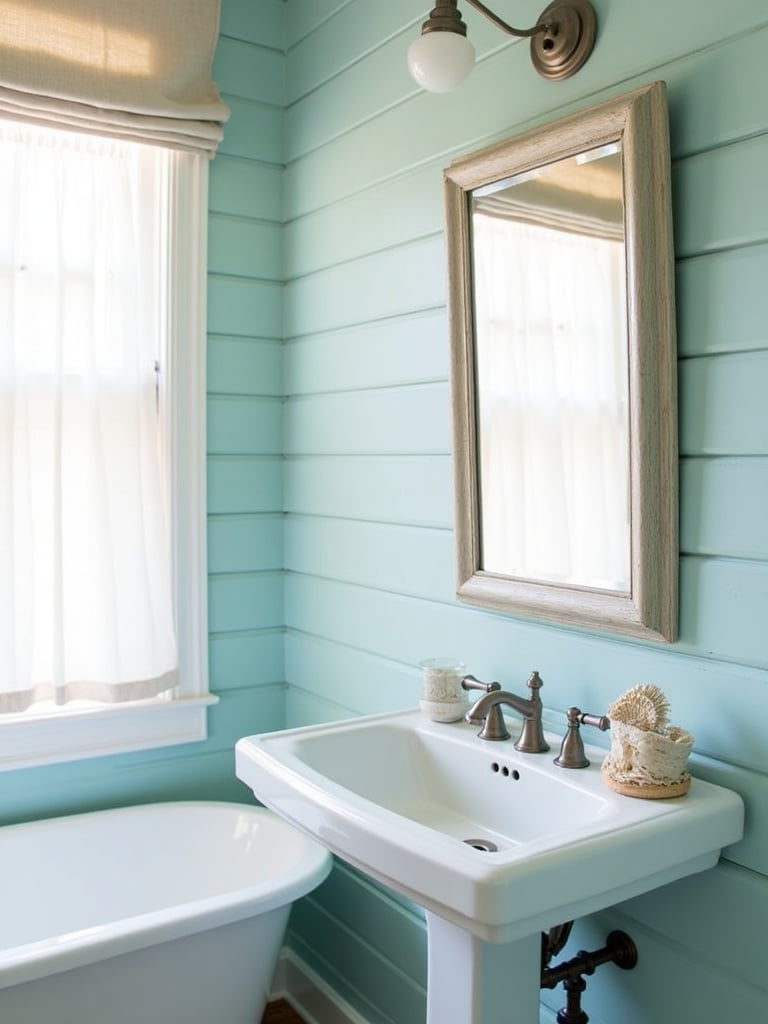
When adding shiplap to a bathroom, material selection is crucial. Traditional wood shiplap offers authentic charm but requires proper sealing in moisture-prone areas. For a worry-free alternative, consider PVC shiplap or ceramic tiles that mimic the look while offering superior water resistance. Color-wise, white shiplap creates a classic, bright coastal look, but soft blues, greens, or driftwood tones can add depth and personality.
The surprising part is how shiplap can actually make small bathrooms feel larger by drawing the eye horizontally across the space, creating the illusion of width. This makes it perfect for compact powder rooms or narrow bathrooms where every visual trick helps.
When it comes to nautical decorative elements, subtlety is key. The difference between a sophisticated coastal bathroom design and a themed caricature often comes down to restraint. In my preservation work, I’ve learned that authentic spaces tell their story through carefully selected details rather than overwhelming displays.

Rope elements offer one of the most versatile and stylish ways to introduce nautical character. Consider a thick rope towel bar, a mirror framed with marine-grade rope, or even rope-wrapped containers for cotton balls and toiletries. Small touches like these add texture and maritime reference without screaming “theme bathroom.” For wall art, vintage maritime prints or framed nautical charts bring historical context and visual interest.
Let me paint you a picture… imagine walking into a bathroom where the blue and white palette sets a serene backdrop, wooden elements add warmth, shiplap creates architectural interest, and just a few well-chosen nautical accents tell the story of the sea. It’s these thoughtful layers that create a truly cohesive coastal bathroom design.
Natural light is the secret ingredient that brings a coastal bathroom design to life. It enhances colors, highlights textures, and creates that bright, airy feeling that’s essential to the coastal aesthetic. In my renovation work, I often find that maximizing light is the single most transformative element in creating an authentic seaside atmosphere.
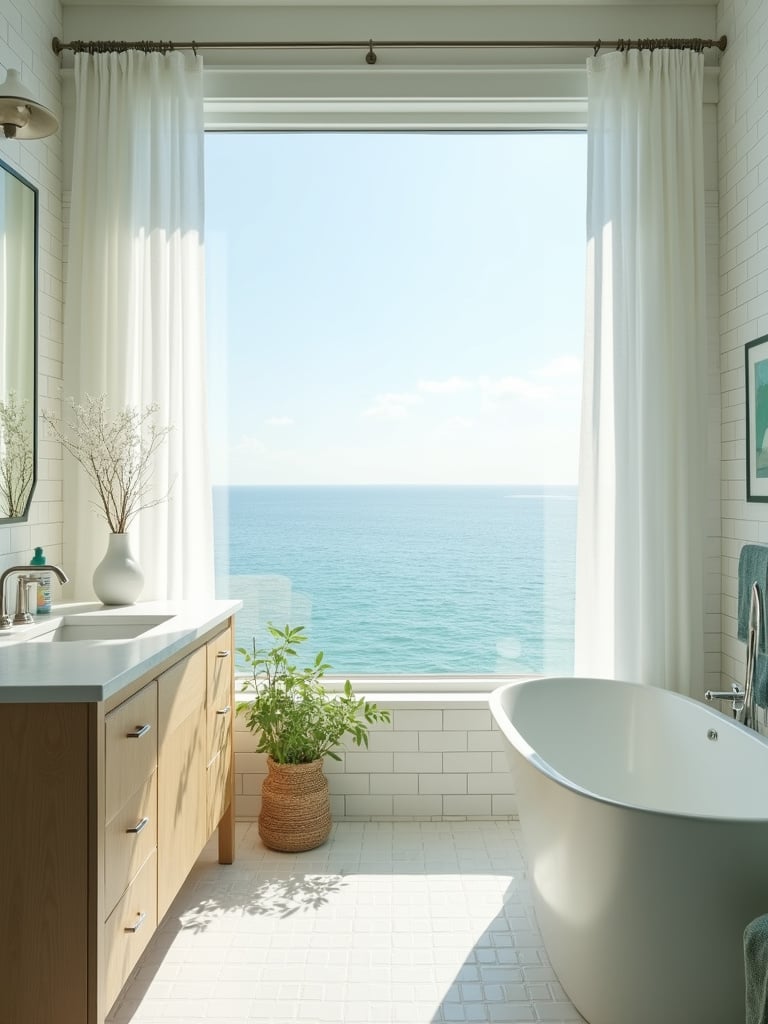
If you’re fortunate enough to have windows in your bathroom, make them a focal point. Consider large windows with minimal framing to maximize glass area, or skylights to bring in overhead illumination. For privacy concerns, frosted glass, sheer curtains, or bottom-up shades allow light while maintaining seclusion. In windowless bathrooms, consider light tubes that channel sunlight from the roof, or use mirrors strategically to amplify available light.
The game-changer happened as I worked on a small north-facing bathroom that always felt dark and cramped. By replacing a solid door with a frosted glass version and adding a skylight, the transformation was remarkable – suddenly the space felt twice as large and infinitely more inviting.
Nothing embodies luxury in a coastal bathroom design quite like a freestanding tub. These sculptural elements serve as both functional retreat and artistic focal point, instantly elevating the space to a true spa-like sanctuary. In historic renovations, I often find ways to incorporate these modern indulgences while honoring the character of the original space.
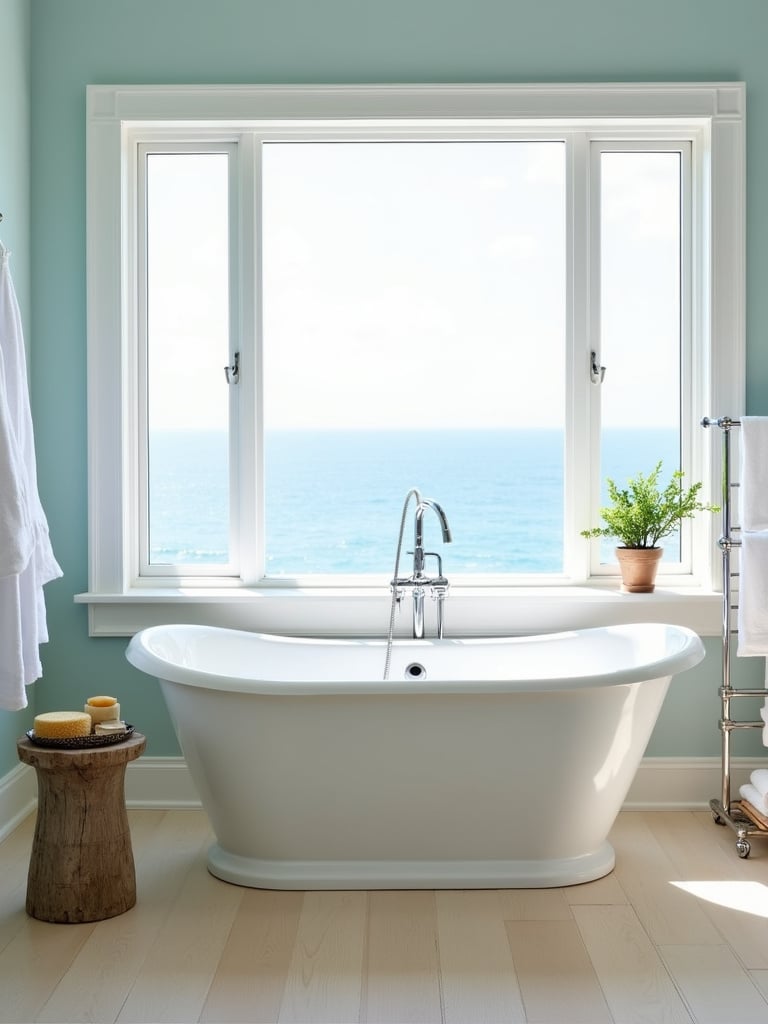
When selecting a freestanding tub, consider materials that complement your coastal theme. Acrylic tubs offer clean lines and lightweight installation, while cast iron provides classic appeal that can be painted in coastal hues. For shape, oval and slipper tubs provide ergonomic comfort with elegant silhouettes. Even traditional clawfoot tubs can be adapted to coastal style with the right paint color and fixtures.
The heart of the matter is creating a true retreat experience around your tub. Add natural elements like potted plants and driftwood accents. Include a small side table for bath essentials. Consider ambient lighting with dimmers to set the mood. These thoughtful details transform a simple bath into a rejuvenating coastal escape.
Vessel sinks offer a distinctive opportunity to introduce coastal character to your bathroom design. Unlike undermount or drop-in options, these above-counter basins become sculptural elements that draw the eye and add artistic flair to the vanity area. Throughout my career in historical renovation, I’ve found that vessel sinks can bridge traditional architecture with contemporary function.
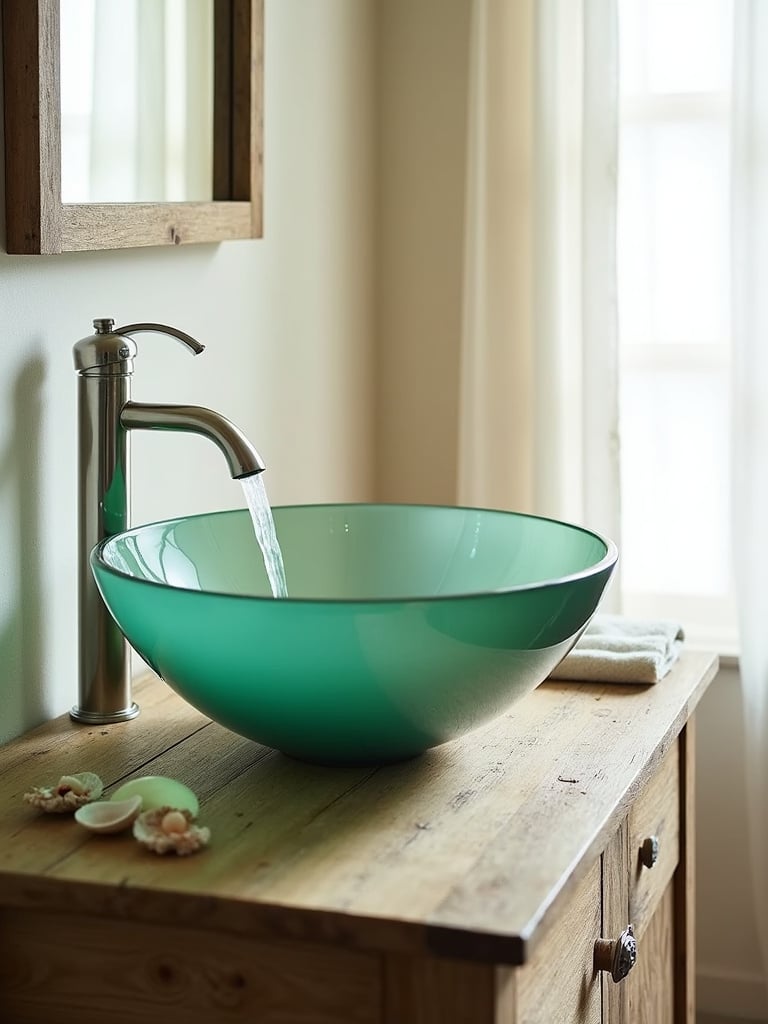
The material selection for your vessel sink can powerfully enhance your coastal theme. Consider glass in sea-blue or aqua tones to evoke water, natural stone with subtle veining that mimics sand patterns, or even ceramic with hand-painted coastal motifs. For a truly unique statement, resin sinks can incorporate actual seashells or beach sand within their design. Pair your vessel sink with a waterfall faucet in brushed nickel or chrome to complete the water-inspired aesthetic.
You might be wondering about practicality – and it’s a fair concern. While vessel sinks create dramatic visual impact, ensure you select one with adequate depth to prevent splashing and pair it with a faucet tall enough to provide comfortable hand-washing space.
Transform your daily shower ritual into a revitalizing coastal experience by installing a rain showerhead. This luxurious feature mimics the sensation of standing in a gentle rainfall, creating an immersive and relaxing experience that perfectly complements a coastal bathroom design. In my renovation work, clients consistently report that this upgrade delivers one of the highest satisfaction rates.
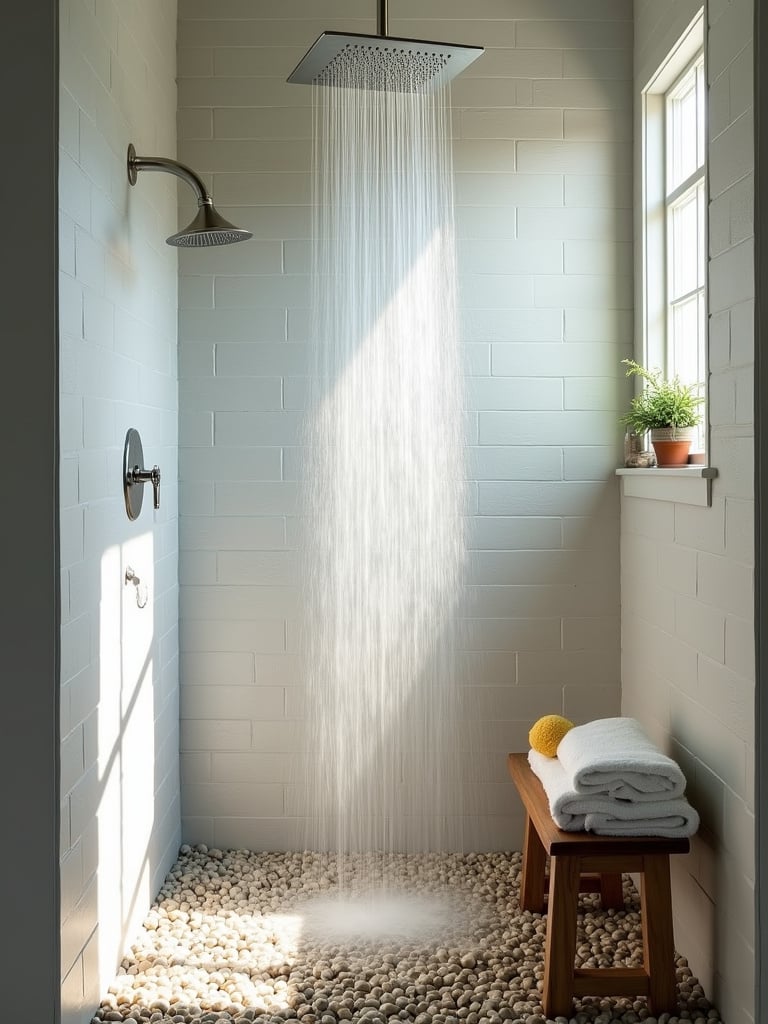
When selecting a rain showerhead, consider both function and aesthetics. Ceiling-mounted options provide the most authentic rainfall experience, while wall-mounted versions with extension arms offer easier installation. Choose large, round or square heads (8-12 inches) for maximum coverage. Brushed nickel or chrome finishes resist water spots and complement the bright, reflective quality of coastal spaces.
The missing piece is often the shower floor. Consider natural stone or pebble tile underfoot to create a sensory connection to the beach. This textural contrast against the smooth rain of water from above creates a multi-dimensional experience that truly transports you to the shore.
Shells and pebbles bring an immediate connection to the shore, adding authentic coastal charm to your bathroom design. These natural elements carry the essence of beach-combing adventures and provide organic texture that manufactured items simply can’t replicate. Through my work with historic properties, I’ve found that these simple elements often create the strongest emotional response.
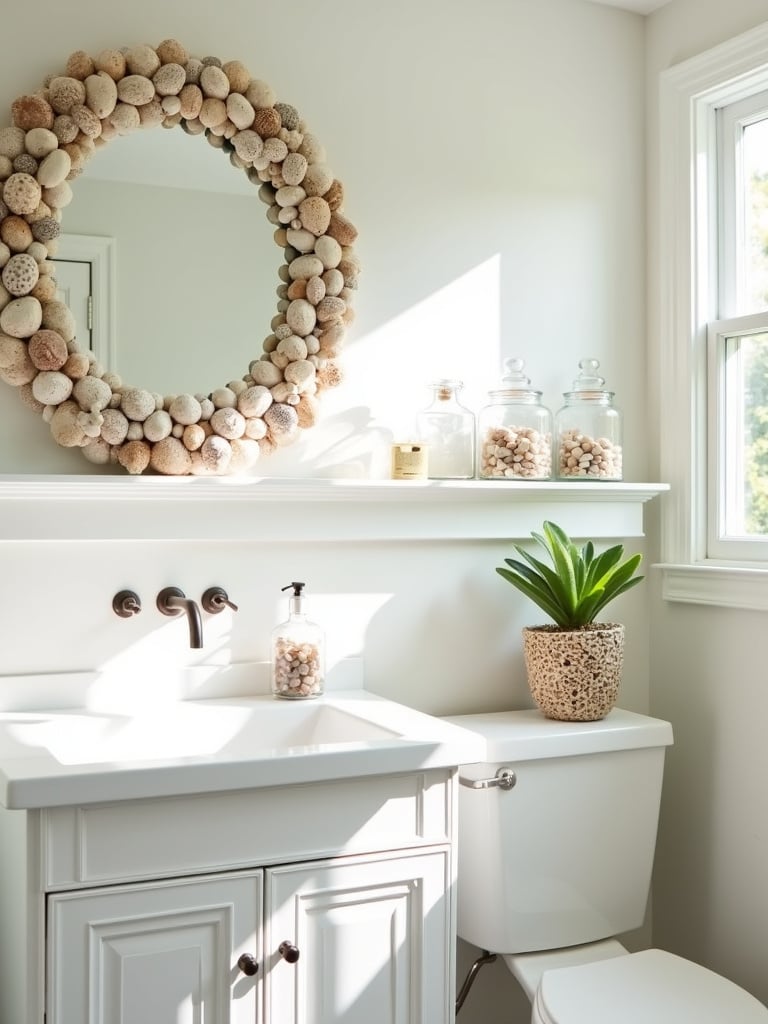
The key to incorporating shells and pebbles successfully lies in thoughtful restraint. Display a collection of similarly-colored shells in a clear glass container on a shelf or vanity. Create a small “beach” vignette with sand and carefully selected shells. Consider embedding smooth pebbles in a bathroom tray to hold soap or jewelry. For a more permanent application, shell-inlaid mirrors or cabinet pulls offer subtle nods to the coastal theme without overwhelming the space.
Do you see how huge that is? These natural elements forge an authentic connection to the coast through actual pieces of the shore, rather than manufactured representations. They bring a personal, collected-over-time quality that makes your coastal bathroom design feel genuine rather than mass-produced.
Mirrors are essential in any bathroom, but in a coastal design, they become opportunities to reinforce the theme through thoughtful framing. Driftwood-framed mirrors bring the weathered, sun-bleached beauty of shore-found wood into your space, creating a focal point with authentic seaside character. I’ve salvaged and repurposed driftwood for numerous historical renovations, preserving its unique patina and organic forms.
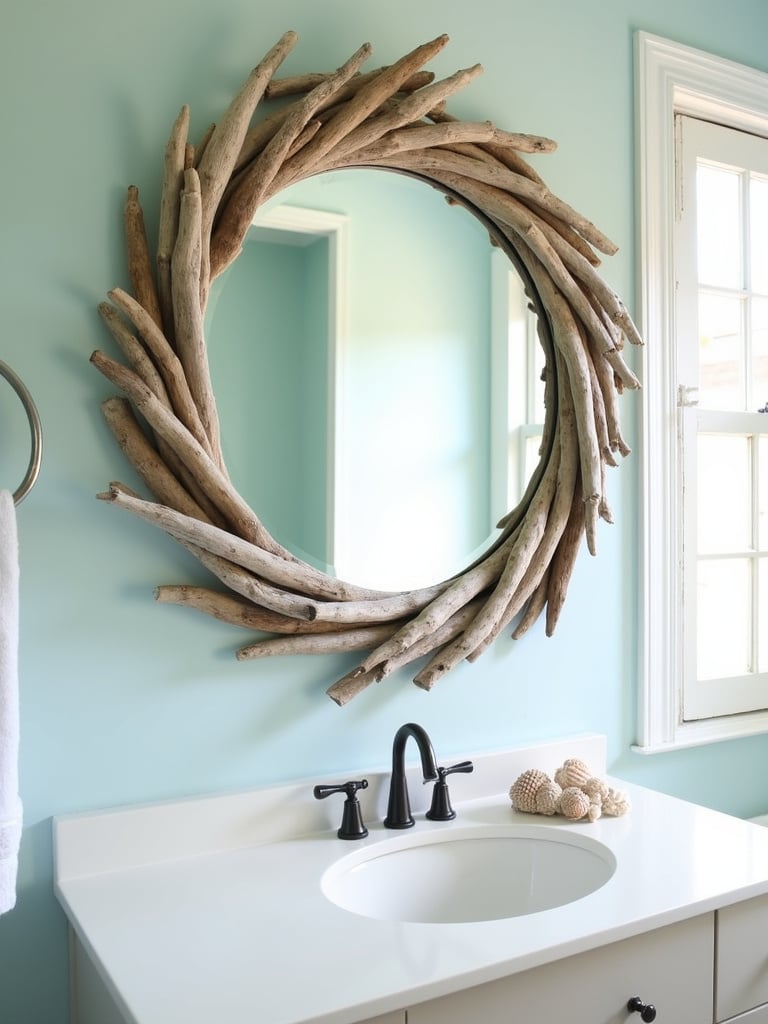
When selecting a driftwood mirror, look for pieces with interesting natural variations and textures. Lighter, silvery driftwood enhances a bright, airy coastal palette, while darker tones add warmth and contrast. Consider the size in relation to your vanity – a statement mirror can anchor the space, while smaller mirrors can be grouped for visual interest. The irregular, organic shapes of driftwood frames soften the hard lines typically found in bathrooms, creating a more relaxed aesthetic.
It works something like this: the mirror reflects light and creates a sense of space, while the driftwood frame adds texture, color, and that crucial connection to the shore. Together, they embody the essence of coastal design – natural beauty meeting functional necessity.
Plants are transformative elements in any coastal bathroom design, bringing vitality, color, and a connection to nature that few other decorative elements can match. In the humid environment of a bathroom, many plants thrive with minimal care, making them both beautiful and practical additions. Throughout my renovation career, I’ve witnessed how even a single well-placed plant can completely shift the energy of a space.
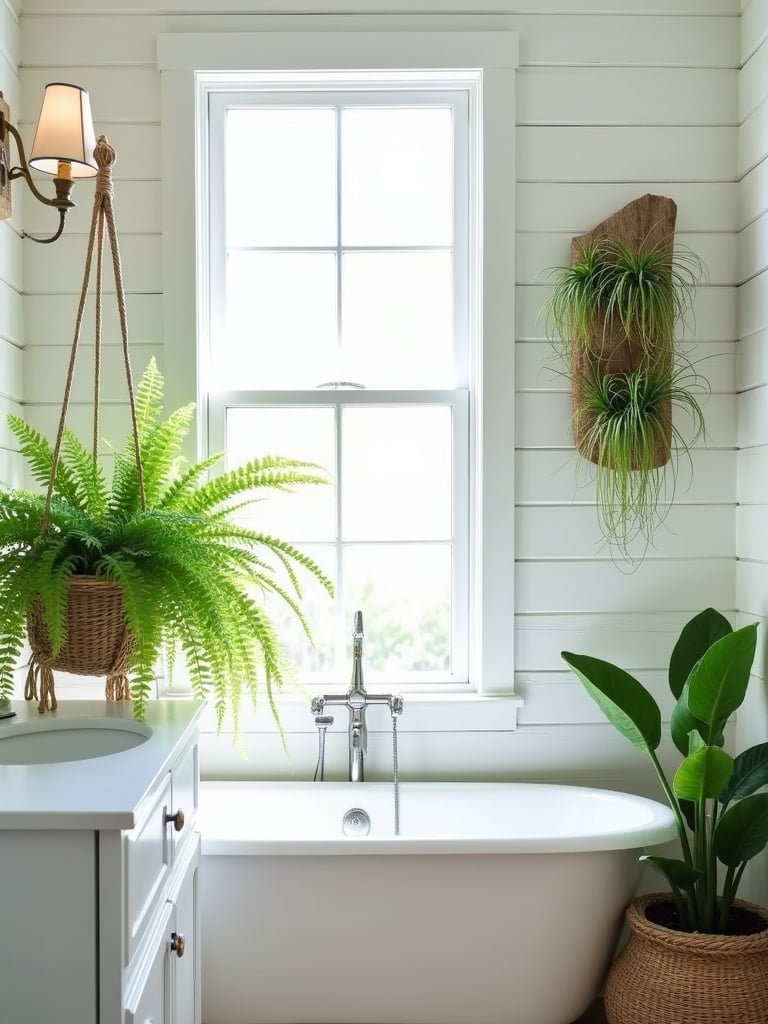
Select varieties that flourish in bathroom conditions: air plants mounted on driftwood or shells require no soil and minimal care; ferns love humidity and add lush texture; orchids bring elegant blooms and tropical flair; aloe vera offers both architectural form and practical benefits. Position plants strategically – hanging planters save counter space, while a large floor plant can fill an empty corner. Use natural containers like woven baskets, terracotta, or weathered wood planters to enhance the coastal aesthetic.
The breakthrough came when I realized plants don’t just decorate a coastal bathroom – they actively contribute to its function. They improve air quality, add humidity beneficial for skin, and create a biophilic connection proven to reduce stress. That’s powerful design that works on multiple levels.
Window treatments in a coastal bathroom design should enhance rather than obstruct natural light while providing necessary privacy. Sheer curtains and lightweight blinds achieve this balance perfectly, filtering sunlight into a soft glow that enhances the airy, open feeling essential to coastal spaces. In historic renovations, I often replace heavy, dated window coverings with these lighter options to dramatic effect.
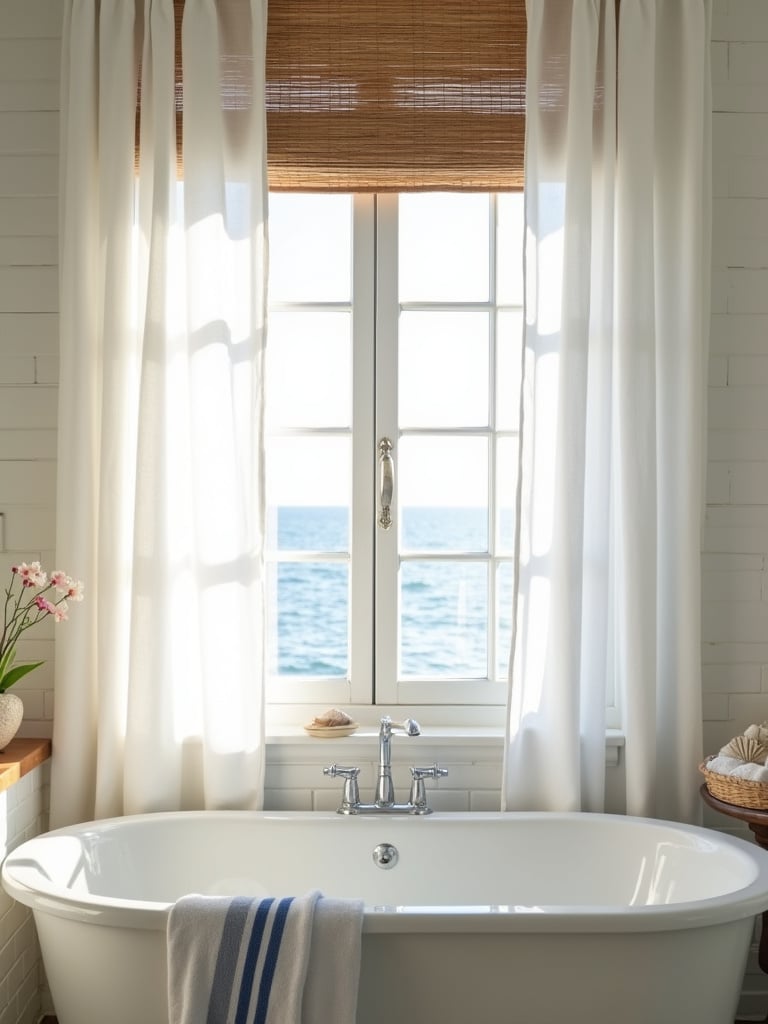
For a truly coastal feel, consider linen or cotton voile curtains in white, cream, or pale blue. These natural fabrics move gently with air circulation, adding a dynamic quality reminiscent of sea breezes. For more privacy control, layer sheer curtains with light-filtering roller shades or consider top-down/bottom-up cellular shades that allow light from above while maintaining privacy below. Woven wood blinds in light tones add natural texture while still allowing filtered light to enter.
What complicates this is balancing light and privacy in bathroom settings. The solution often lies in layering – using frosted glass or privacy film on lower portions of windows while keeping upper sections clear, or installing sheer curtains that can be supplemented with more substantial coverings when needed.
Storage solutions in a coastal bathroom design should be as beautiful as they are functional. Woven baskets and containers made from natural materials like seagrass, rattan, and jute not only organize essentials but also reinforce the coastal aesthetic through their organic textures and neutral tones. In my preservation work, I’ve often incorporated these elements to add period-appropriate storage that feels neither clinical nor utilitarian.
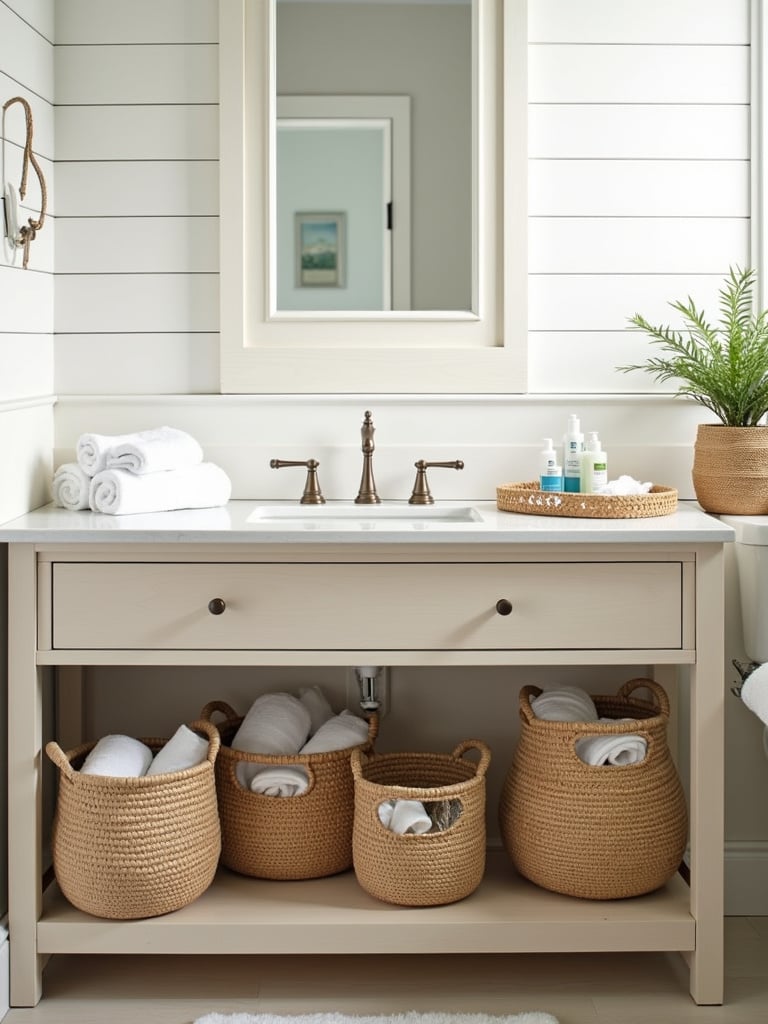
Utilize these natural containers throughout the bathroom: large baskets for towels or laundry; medium-sized containers for toilet paper and extra supplies; small trays and boxes for cosmetics and personal items. The varied textures add visual interest while the consistent use of natural materials creates cohesion. Look for pieces with tight weaves and quality construction for bathroom durability, and consider lining baskets that will hold damp items.
“Storage should never be an afterthought in bathroom design. When done right, it becomes an integral part of the aesthetic rather than just a functional necessity.” – My design philosophy after years of renovation work
Artwork provides the perfect opportunity to reinforce your coastal bathroom design through color, subject matter, and mood. Sea-inspired prints and paintings create focal points that draw the eye and establish the maritime theme without requiring permanent fixtures or major renovations. In historical properties, I often use art to introduce coastal elements while preserving original architectural features.
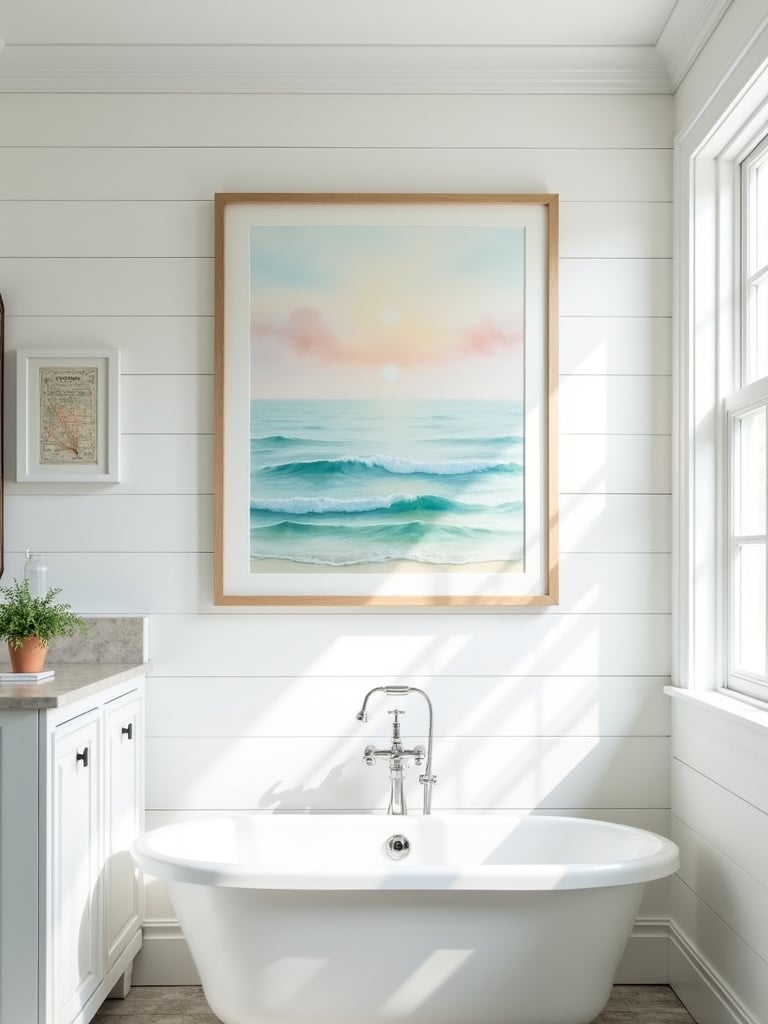
Choose pieces that complement your overall color scheme and style. Watercolor seascapes in soft blues and greens add serene beauty. Vintage nautical charts bring historical interest and sophisticated detail. Botanical prints of seaweed, coral, or coastal plants offer subtle thematic references. Black and white photography of beaches or ocean waves provides dramatic contrast in predominantly light spaces. Consider grouping smaller pieces in a gallery arrangement for greater impact, or select one large statement piece to anchor a wall.
Things took an interesting turn when I started recommending clients frame actual maps of their favorite coastal locations or beaches with special memories. This personal connection transforms generic coastal decor into meaningful storytelling that makes the space uniquely theirs.
Hardware and fixtures are the jewelry of your coastal bathroom design – small but significant elements that add refinement and cohesion. Brass and chrome are particularly effective choices, each bringing distinctive qualities that complement the coastal aesthetic. Throughout my renovation career, I’ve seen how these metallic accents can elevate a space from simply themed to sophisticatedly designed.
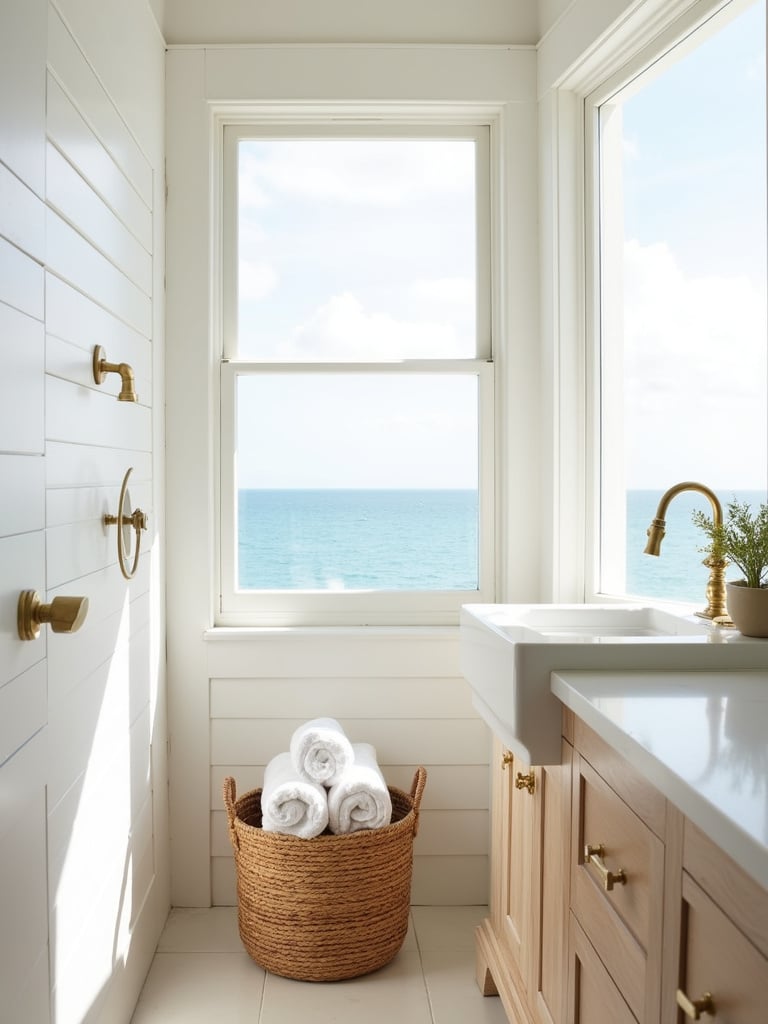
Brass adds warmth and vintage nautical charm, particularly in polished or unlacquered finishes that will develop a living patina over time. Its golden tones contrast beautifully with blue and white color schemes, adding depth and visual interest. Chrome, meanwhile, offers a bright, reflective quality reminiscent of sunlight on water. Its clean, contemporary look works particularly well in modern coastal interpretations. Both metals resist corrosion, making them practical choices for humid bathroom environments.
The tricky part is achieving balance. Use your chosen metal consistently throughout the space – faucets, shower fixtures, towel bars, cabinet hardware – but don’t overdo it. The metal should accent the coastal elements, not compete with them.
Textural contrast is essential in any well-designed space, and in a coastal bathroom, natural fiber rugs provide the perfect counterpoint to smooth tiles and porcelain surfaces. Jute and sisal rugs bring warmth, comfort, and organic texture that literally grounds the design by connecting it to natural elements. I’ve incorporated these rugs into countless bathroom renovations to add both practical comfort and visual interest.

When selecting between jute and sisal, consider their characteristics in relation to your specific needs. Jute offers a softer feel underfoot but is more absorbent and susceptible to staining. Sisal provides greater durability and moisture resistance but has a coarser texture. For bathrooms with high moisture levels, look for blended rugs that incorporate synthetic fibers for added durability, or consider cotton rugs with coastal patterns as alternatives. Size-wise, a runner in front of a vanity or a small area rug centered in the room typically works best, leaving some tile visible around the edges.
My breakthrough came when I started layering rugs – placing a smaller, more absorbent cotton bath mat over a larger jute rug. This creates visual interest through texture variation while providing practical function where it’s most needed.
The textiles in your coastal bathroom design provide both functional necessity and opportunities for texture, color, and pattern. Linen and cotton are ideal materials, offering natural fibers that are absorbent, breathable, and inherently connected to coastal living. Through years of historical renovation, I’ve found that quality textiles can transform utilitarian bathrooms into luxurious retreats.
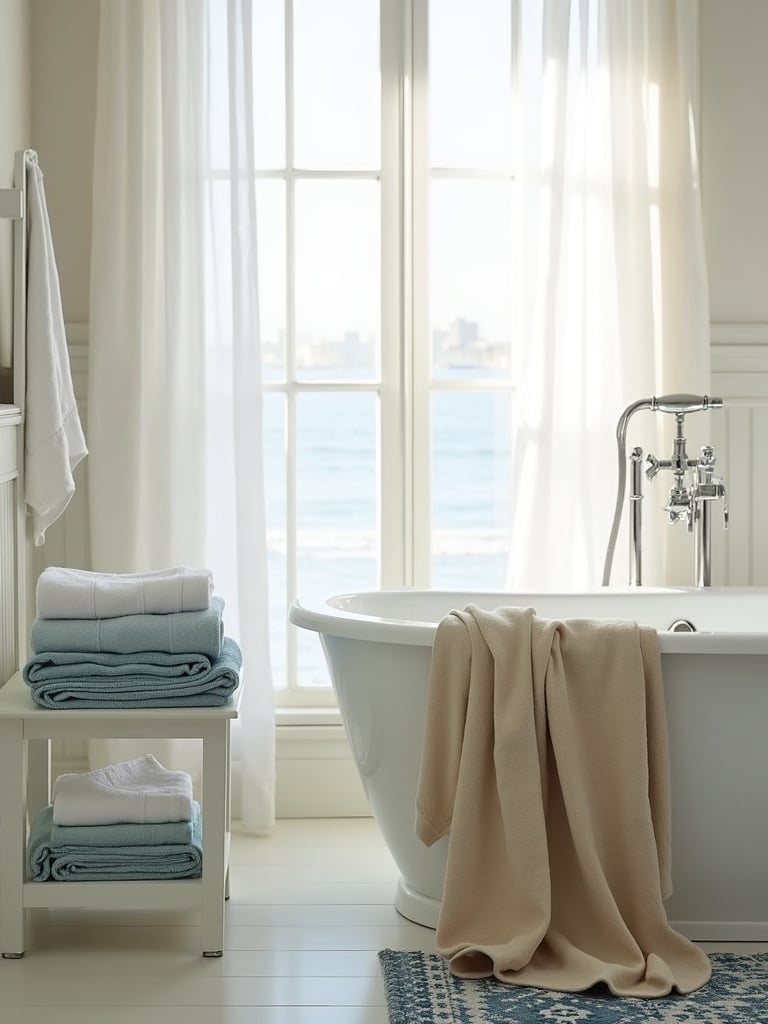
Layer these materials throughout your space for maximum impact: plush cotton bath towels in whites or sea-inspired blues; hand towels in complementary patterns like subtle stripes or small-scale geometrics; washcloths in coordinating solids. Add a linen shower curtain for elegant drape and natural texture. Consider a cotton bath mat with a subtle coastal motif or simple border detail. For added luxury, include a linen bathrobe hanging on a hook or a small cotton throw draped over a chair or stool.
Here’s what’s happening… these soft textiles not only provide comfort and function but also introduce opportunities for color, pattern, and texture that can be easily changed seasonally or as design preferences evolve. They offer low-commitment ways to refresh your coastal bathroom design over time.
Beyond the driftwood frames discussed earlier, statement mirrors in coastal bathroom design can take many forms, each creating a distinctive focal point that anchors the space. As a focal element, these mirrors should embody the coastal theme while providing the practical function of reflection. In my renovation work, I often find that the right mirror can completely transform a bathroom’s character.
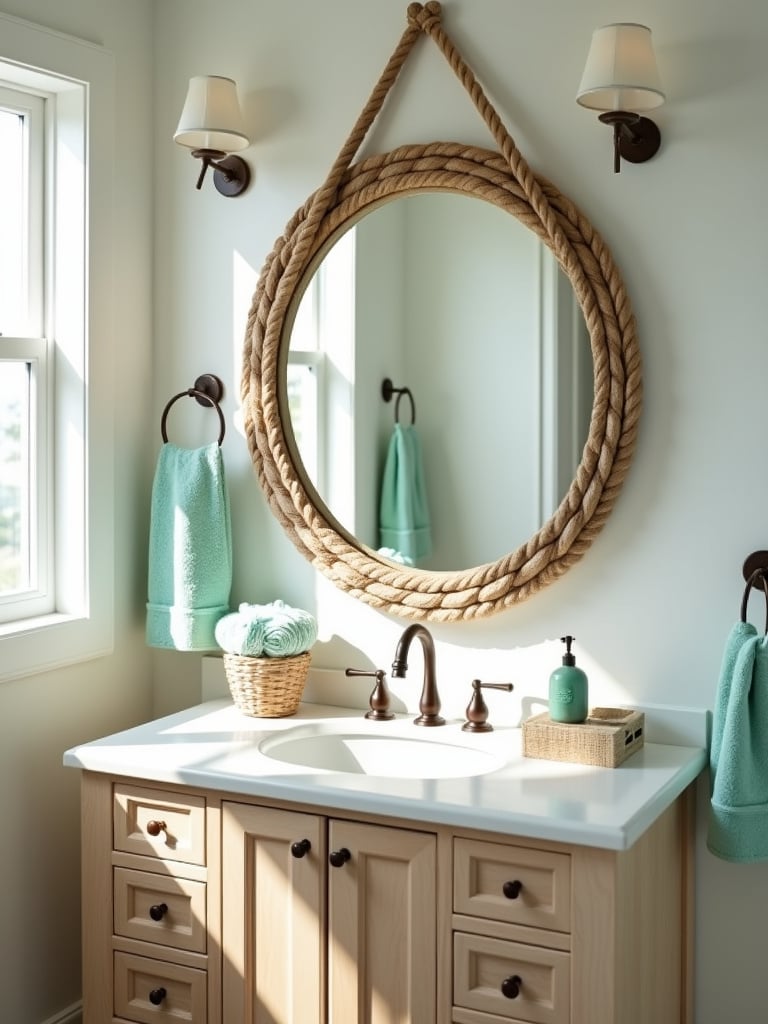
Consider mirrors with distinctive coastal-inspired frames: rope-wrapped circular mirrors that evoke nautical portholes; mirrors framed with carefully arranged shells for authentic beach character; weathered or painted wood frames in coastal colors that complement your palette; metal frames with nautical details like cleats or star motifs. The shape can further enhance the theme – round mirrors suggest portholes or bubbles, while scalloped edges evoke waves and seashells.
The crucial element is proportion. A statement mirror should be sized appropriately for your wall space and vanity. Too small, and it loses impact; too large, and it can overwhelm the space. The mirror should be a focal point that draws attention while still harmonizing with the overall design.
The vanity is often the largest furniture piece in a bathroom, making it a critical component of your coastal design strategy. Today’s “smart” vanities combine thoughtful storage solutions with stylish design elements that enhance the seaside aesthetic. Throughout my career in historical renovation, I’ve found that vanities offer the perfect opportunity to blend period-appropriate style with modern functionality.
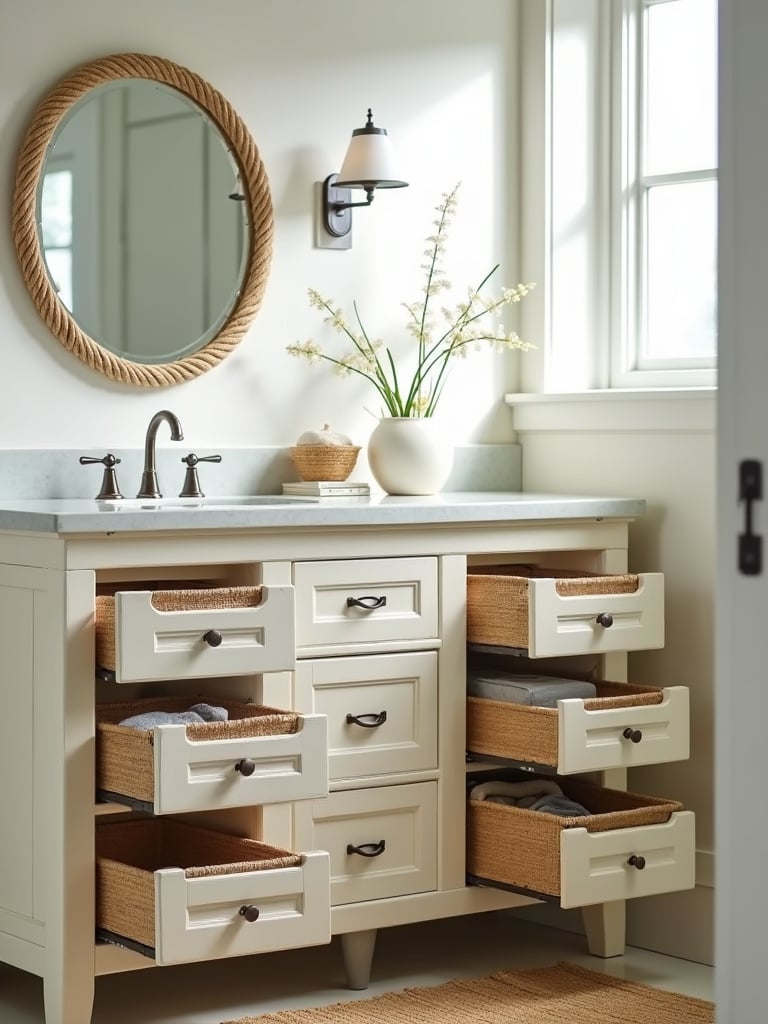
Look for vanities that maximize storage through intelligent design: deep drawers with organizers for toiletries; vertical storage solutions that utilize wall height; pull-out shelves that offer full access to contents; integrated electrical outlets for hair tools and charging devices. Stylistically, choose finishes that reinforce your coastal theme – painted wood in white or soft blue; natural wood with a weathered or driftwood finish; details like beadboard or shiplap panels that echo architectural elements. For countertops, light-colored quartz or marble with subtle veining evokes sandy beaches and ocean waves.
It’s kinda like creating a beautiful piece of furniture that happens to hold plumbing. The most successful coastal vanities balance form and function, providing essential storage while contributing significantly to the room’s aesthetic appeal.
The final touch in creating a comprehensive coastal bathroom design engages the often-overlooked sense of smell. Aromatherapy that evokes the seaside creates a multi-sensory experience that truly transports you to the coast. After years of creating spaces that engage visually and tactilely, I’ve come to appreciate how powerfully scent completes the sensory experience.
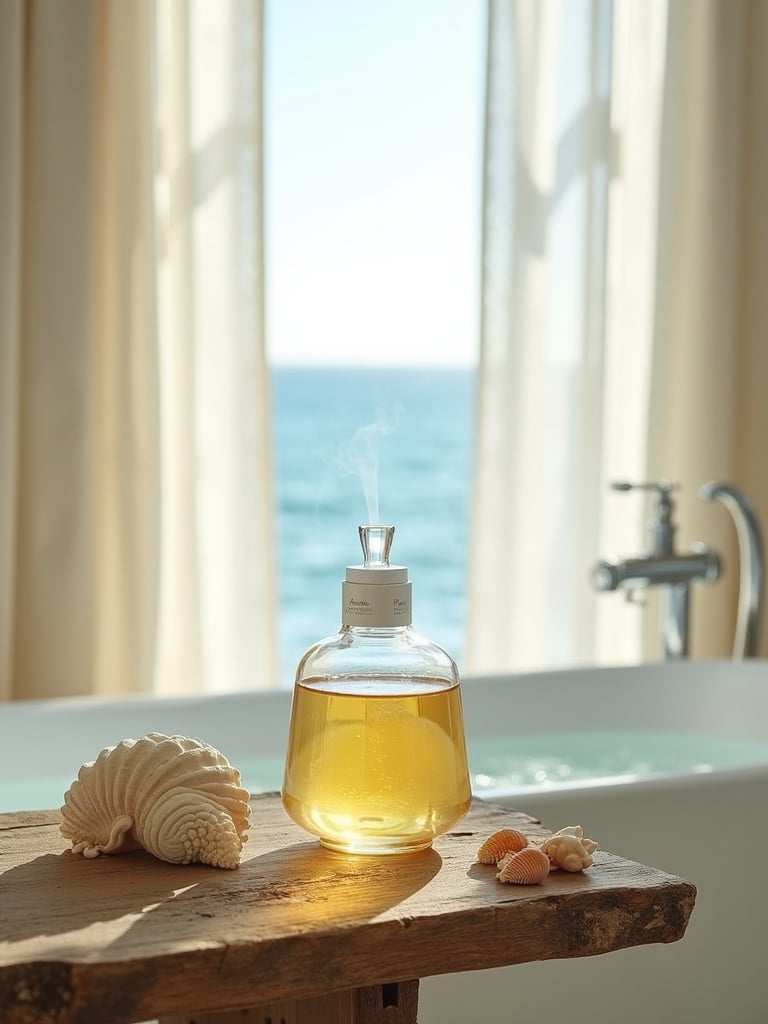
Select fragrances that authentically capture coastal elements: sea salt and ocean air for freshness; driftwood and cedar for warmth and earthiness; citrus notes like bergamot or grapefruit for brightness; light florals like jasmine or freesia for subtle sweetness. Deliver these scents through reed diffusers, which provide consistent fragrance without flames; essential oil diffusers that can be programmed for intermittent scenting; or high-quality candles in coastal-inspired vessels. Avoid overly synthetic or heavily perfumed options that can feel artificial or overwhelming.
Before you raise an eyebrow at this “extra” element, consider that scent is directly linked to memory and emotion. The right coastal fragrance can trigger relaxation and positive associations with beach vacations and seaside retreats, enhancing the overall experience of your coastal bathroom design.
Transforming your bathroom into a coastal retreat is about more than just decorating with seashells and blue paint. It’s about creating a multi-sensory experience that captures the essence of the shore – the light, the textures, the colors, and the feeling of relaxed elegance that comes from being near the water.
By thoughtfully incorporating these 20 elements, you’ll create a coastal bathroom design that feels authentic rather than themed, sophisticated rather than kitschy. Remember that the most successful coastal spaces balance practical function with aesthetic beauty, creating rooms that work beautifully while transporting you to your favorite seaside destination every time you step through the door.